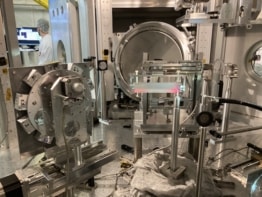Evidence for axions is once again mounting as researchers claim the hypothetical particles can explain how very high-energy photons travel unimpeded through the cosmos.
Such photons and other neutral cosmic rays (aside from neutrinos) should be unable to travel inter-galactic distances because they are absorbed by the universe’s opaque background of microwaves — yet they are still detected on Earth.
“If this could be confirmed, it would be an enormously important discovery” Dan Hooper, Fermilab
Now a group led by Malcolm Fairbairn of King’s College, London, has found a correlation between where detected cosmic rays originate and where photons and axions are more likely to “mix”. The result implies that cosmic-ray photons could reach Earth from distant galaxies by temporarily converting into axions, which can bypass the microwave background without absorption.
“If this could be confirmed, it would be an enormously important discovery,” says Dan Hooper, a physicist from Fermilab in the US who performed a similar study last year.
Old problem
Axions were first proposed in the late 1970s to solve an issue in particle physics known as the strong-CP problem. Theory suggested the elementary particles would be very light and would interact very weakly with matter — so weakly, in fact, that no one has yet managed to detect them.
Fairbairn’s group — which includes Timur Rashba of the Max Planck Institute for Solar System Research and Sergey Troitsky of the Russian Academy of Sciences — has been looking for an astrophysical equivalent of an effect being sought in laboratory axion experiments. In these “shining light through the wall” experiments, a laser is shone onto a wall in the presence of a magnetic field. If some of the laser’s photons covert into axions, they could travel freely through the wall, revert to photons and then be detected on the other side.
The hope of Fairbairn and colleagues is that, on a cosmic scale, the “wall” could be provided by the microwave background, and the magnetic field could be provided by galaxies.
To see if this “shining light through the universe” effect exists, Fairbairn’s group has performed a statistical analysis of neutral cosmic rays of energies above 1018 eV recorded by the High Resolution Fly’s Eye (HiRes) detector in Utah. Previous studies have already highlighted a correlation between the arrival locations of these cosmic rays and the known locations of highly luminous “active” nuclei of distant galaxies. But Fairbairn’s group has shown that there is an additional correlation with the likely profile of our own galaxy’s magnetic field, which determines the probability of photon-to-axion conversions. The researchers say the likelihood of the correlation occurring by coincidence is just 2.4% (arXiv:0901.4085).
Proof is ‘far away’
Fairbairn told physicsworld.com that the result is definitely new evidence in favour of axions but warns that it needs to corroborated by more data. “It’s still far away from proving anything,” he adds. “Very, very far.”
If the axion does indeed exist, it would be particularly light (less than 10–7 eV) and have a particularly weak coupling with photons (an inverse coupling of 1010 GeV). This latter property rules it out as a solution to the decades-old strong-CP problem by several orders of magnitude. However, is there is still a question as to whether it could fulfil the other possible role of axions — that of the cold dark matter that generates most of the universe’s gravity.
Theorists expect dark-matter particles to be heavier than 10–7 eV, because it means they can be generated sooner after the Big Bang and then spread out into the low densities given by experimental cosmology. But Aaron Chou, a spokesperson of the GammeV axion experiment at Fermilab, suggests that we might just live in a region of the universe where dark matter happens to be less dense. “In short,” he explains, “this model could also produce axion-like dark matter, but just not in a generic fashion.”
Nonetheless, the study by Fairbairn’s group does back up work by Hooper, Pasquale Serpico of CERN and Melanie Simet of the University of Chicago, who found a similar correlation for lower energy photons last year (Phys. Rev. D 77 063001; arXiv:0712.2825). Hooper and Serpico point out — and Fairbairn admits — that there is no way of knowing how many of the neutral cosmic rays detected by HiRes are actually photons, as all it can detect are the subsequent showers when the rays collide with the Earth’s atmosphere. Moreover, Serpico has doubts on the effectiveness of the photon-to-axion conversion mechanism at such high energies.
Previous mistakes
It would not be the first time that axions have tempted physicists into believing in their existence. In 2006 there was hope for experimental proof in an Italian experiment called PVLAS, which registered a slight change in the polarization of a laser beam as it passed through a magnetic field in a vacuum. The PVLAS researchers thought the change could have resulted from some of the laser beam’s photons combining with photons in the vacuum to produce axions. However, they later found the signal to be an experimental artefact.
The only course of action for Fairbairn’s group now is to await more data from other cosmic ray searches, such as the Pierre Auger Observatory in Argentina. In the meantime, they can still hope a lab-based experiment will see evidence for the same type of axion.
Konstantin Zioutas of CERN is spokesperson for CAST, the only existing axion experiment that has the potential sensitivity to search for Fairbairn and colleagues’ axion. He says that to begin looking CAST would require an upgrade, which is “within reach” in a few years. “If this idea is definitely confirmed, it will be a breakthrough for cosmology and particle physics alike,” he says.



